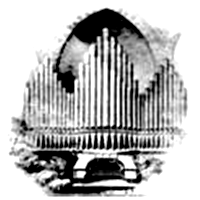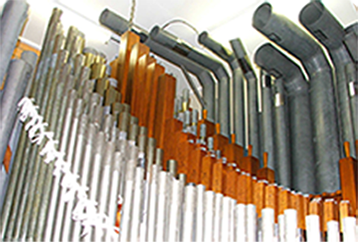
Company Logo
The United States Pipe Organ Company was formed as a Pennsylvania Corporation on January 1, 1923. The name of the company was chosen because of patriotic feelings in the U.S. following World War I. The firm was located in Crum Lynne, Delaware County, Pennsylvania, and the legal owner was Gustav H. Kloehs. Kloehs had a partner, however, Gus Payne. They were financed by Philadelphia “Brick Baron” O.W. Ketcham. The organ fabrication plant was built in Crum Lynne, next door to Ketcham’s terra cotta works.
The company built about 200 Theatre Pipe Organs. It is believed that Opus numbers started with #50. Some instruments went to Philadelphia area theatres, while others were shipped all over the country. Production was exclusively Theatre Pipe Organs. The instruments were called the “Kloehs Unit Orchestral Organ”. The company did not build church or classical instruments.
An online search finds reference to several pipe organ patents acquired by Gustav Kloehs. The most important patent was for a device that Kloehs called “Cipherless”. An additional set of tabs were place on the console. Each tab controlled a chest. When activated, the tab closed a valve, denying air to that chest. So let’s say the organist is accompanying a silent movie and a Vox Humana pipe starts ciphering. Rather than disrupt the performance to have someone run into the chamber and pull the offending pipe, the artist simply could activate the “Vox Humana Cipherless” tab, shutting off the air to the entire rank.
In practice, many organists were confused by the system, and would activate all the tabs at once resulting in a dead organ and a service call. Many of the devices ended up being deactivated because of this problem.
The United States Pipe Organ Company fabricated most of the wooden parts of its instruments (consoles, wind chests, regulators, tremulants) and purchased other parts. Pipes came from Durst (today’s Organ Supply Industries) and Gottfried, switches from Reisner, stop tabs from Hesko.
Unfortunately, Kloehs and Payne were dead set against the soldering of wiring (Probably a fear of poisonous vapors, which was not unfounded. Today lead is banned from solder). All electrical connections in US Pipe Organ Company instruments were mechanical, rendering the organs unreliable, and eventually resulting in a bad reputation for the company.
We all know that the first talking movie, “The Jazz Singer” starring Al Jolsen, brought on the demise of the Theatre Pipe Organ. At US Pipes, however, manager Conrad Boyer went to a showing of the film that was badly executed. Boyer came back to US Pipes and announced that the new technology was a failure, and that the company should redouble its efforts to market its instruments. A campaign was started to sell organs to theatres with payments accepted on an installment basis. As the talkies took off, virtually all the theatres in the new time payment program reneged on their contracts, and the organs had to be repossessed by the company. US Pipes then placed a number of these instruments in poor Philadelphia area minority churches. It is ironic that a company which exclusively produced Theatre Organs had a major portion of its product end up in churches. It is believed that a number of the company’s organs are still hidden away in Philadelphia churches in such places as 50th and Woodword, 48th and Spring Garden, several in Chester. Pa, and one in Oxford Pa.
As of June, 2011 there was a seven rank US Pipe Organ Company instrument, Opus 204, listed for sale at www.theatreorgans.com. The seller stated that its first home was in the State Theatre, West Orange, N.J. It then played in a private residence in Summit, N.J before being acquired by the seller. Unfortunately, the offered instrument came with no console, reservoirs, or tremulants, precisely the components US Pipes built from scratch!
The most famous organ produced by the company, Opus 101, currently resides at Sunnybrook Ballroom in Pottstown, Pa.

As the Theatre Organ age ended, the US Pipe Organ Company morphed into an organ maintenance, tuning, and rebuilding company.
In the 1950s, we find that Gustav Kloehs had left US Pipes and Philadelphia and was functioning as a Pipe Organ salesman for Robert B. Hoffman, a Schantz pipe organ dealership in Coral Gables, Florida. He was described as a “former pipe organ manufacturer from Philadelphia” who was educated at Boston Technical College.
US Pipes continued on in business until 1981 when Bob Lent bought the assets of the company and changed its name.
(Thanks to Bob Lent for contributing the majority of the information for this article.)
After graduating high school in 1968, Robert G. Lent, current President of Shenandoah Organ Studio in Virginia, was hired by the United States Pipe Organ Company as a mechanic’s helper. By 1970, he was a full time road mechanic performing routine maintenance, tuning and rebuilding for the company. A major slow down in the organ industry in 1971 caused a severe cut back in personnel at the United States Company and he was out of work.
By 1974, United States Pipe Organ Company had recovered from the lack of work and actively recruited Bob to come back. By 1978, he had taken over as general manager in charge of all operations. In 1981, Bob and his wife, Jean, purchased all the assets of the United States Pipe Organ Company, moving all operations to Bayville, New Jersey. Due to the company’s poor reputation, the name was changed to R.G. Lent Pipe Organ Service Inc., and continued to operate until 1986 when the company was sold to another organization.
In 1986 Bob Lent donated a file cabinet full of the records of the US Pipe Organ Company to the ATOS archives.










